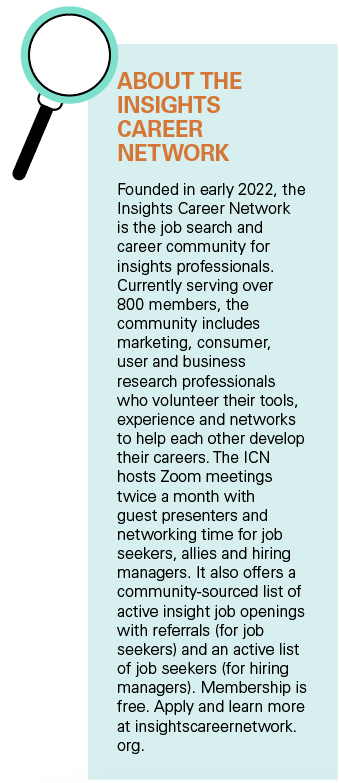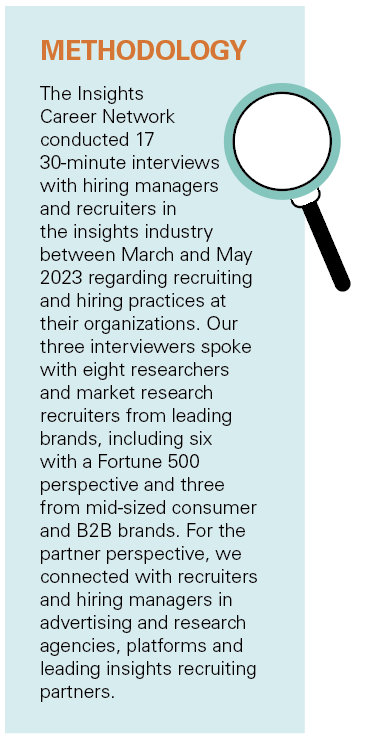Editor's note: Stephen Griffiths is consumer insights director at UnitedHealthcare (Level2) and a co-founder of ICN. Brian Fowler is a strategy consultant and co-founder of ICN. Caitlin van Niekerk is client development manager at Quantilope and an ICN member.
As the hiring landscape evolves, what are the newest trends among hiring managers, specifically those in marketing research? What best practices should job seekers and hiring managers follow during the hiring process in 2023?
The Insights Career Network (ICN) – a peer-to-peer volunteer community of over 800 insights professionals – conducted a series of 17 interviews with recruiters and hiring managers to answer these questions. The interviews revealed some intriguing insights about case study interviews, the evolution of remote work and the use of automatic video interviews, along with specific tips for seekers and recruiters.
Key findings
Growth of case study interviews. While behavioral interview questions are still the mainstay of the interview process, what is emerging is a new kind of interview: the case study. Rather than being asked to recount a past experience, interviewees are asked to do hands-on work: analyze and summarize data, create a presentation to present during a panel interview or create a learning plan for a senior-level audience. While this type of interview can be polarizing – many job seekers feel that these in-depth presentations include work they should be paid for – it is nonetheless popular among many hiring managers. One hiring manager put it this way, “I find I absolutely need case studies for individual contributors. By using a case study, for example, I learned that someone didn’t have the necessary quant skills. In short, we found things that were not uncovered any other way.”
Hybrid is the new normal, though research partners are more likely to offer remote options. In our interviews, we consistently found that hybrid work – requiring employees to work in the office at least a few days a week – is the new norm, even for many companies that hired remote workers during the pandemic. This transition to hybrid is especially common for client-side roles, many of which tend to have a large headquarters building that would otherwise be unused. This presents an opportunity for companies – more likely to be agencies and partners – who get a wider array of candidates when they choose to allow employees to work remotely.
Automatic video interviews are on the rise, though not as prevalent for insights roles. While the general hiring process is largely unchanged from the past 10 years – screening interview by HR, interview by hiring manager and then progressive interviews with other team members and leaders – there is one large exception: the advent of the automatic video interview. Candidates are sent a link and then asked to answer a set of questions while being automatically recorded, with a limited number of retakes. Many candidates find this method impersonal and nerve-racking and hiring managers see them as polarizing. While these types of interviews are most common for positions where there are lots of applicants (especially entry-level jobs), some hiring managers we spoke with opted to not use them because the number of qualified candidates for their niche positions was smaller and they worried the automatic video interviews would be a turnoff for some candidates. It does appear that these interviews can present a cost savings for companies (especially when analyzed by AI), so they are likely to remain a part of many hiring processes.
Growth of contract and project work. Many hiring managers we spoke to mentioned the increased use of contract workers for specific projects. While some job seekers are wary of such roles – instead preferring full-time positions that are more likely to provide bonuses and insurance benefits – some job seekers see these positions as a way to provide variety and flexibility in their lives. Of note, contract work varies widely across industries and companies. For instance, many large tech firms use contract work as a direct route to full-time hiring, often converting contract employees to full-time employees in three to nine months. Other companies use contract employees to temporarily fill a gap, with little chance of a full-time conversion. Job seekers would be wise to ask clarifying questions to determine if a contract position is likely to turn into a more permanent position when presented with contract opportunities.
Tips for job seekers
Although job seekers were not specifically interviewed in this research, there are a number of takeaways that we can share based on twice-monthly ICN meetings with hundreds of members and some basic implications from this research.
Focus on networking. Hiring managers repeatedly mention how candidates often come from internal referrals or those who make themselves known to the HR or hiring manager on LinkedIn. Although they can be uncomfortable, virtual coffee chats with company employees or direct outreach to a hiring manager through LinkedIn are still very effective ways to land that first interview.
It’s worth tailoring your interviews and applications for each role. While it can be tempting to apply to as many positions as possible, hiring managers repeatedly talk about how going the extra mile helps candidates stand out. Although there is no single way to rise to the top of the applicant pool, hiring managers cite examples such as writing a customized cover letter (when no cover letter is required), tailoring your interview answers to the needs of the company and editing 10% of your résumé to match the job description as common ways to separate yourself. Job seekers would be better off networking and tailoring their applications for 20 positions than applying to a hundred roles with no customization at all.
Confidence and preparation trump meeting all qualifications. For competitive roles, it can be tempting to not even apply unless a job seeker meets all the qualifications. On the contrary, many hiring managers mentioned “passion and drive” as key qualities they were looking for – and that the job posting was at times a wish list. One hiring manager described it this way, “Sometimes we focus too much on technical skills rather than the ability to make things happen within an organization. For instance we almost hired someone who has good NPS experience but no track record of implementing change within a company.” Hiring managers go on to suggest applying for a job when you have met 70% of the qualifications, noting that they would prefer to hire someone who was driven and proactive to learn the last 30% than someone who met 100% of the qualifications but was largely complacent.
Tips for hiring managers
A number of themes emerged from hiring managers for how to improve the hiring process in general.
Be candid with candidates. One head of insights shared, “Give an accurate description of the role and company – don’t sugarcoat it to the candidate. Encourage transparency so it can be a good fit from the start.” While many hiring managers try to paint a rosy picture of the organization and position to new candidates in an effort to persuade them to accept the role, this often backfires three months in when the candidate learns the truth and leaves. Instead, be honest with candidates up front about the work hours, a difficult stakeholder or pace of work. Better to get fewer candidates moving through the interviews as long as they are a better fit.
Consider case study interviews to evaluate technical skills but don’t overdo it. If using a statistical package or detailed Excel formulas is a key part of the job, consider asking candidates to do this kind of work as part of the interview process. “If there is a highly technical role, we might do a small case study … we don’t want to create an interview process where candidates are doing large amounts of work for free.”
Ask candidates to present material to gauge presentation skills. One hiring manager shared how a new hire wasn’t the right fit, largely because the new hire couldn’t present well to a senior audience. When interviewing for more candidates, the hiring manager asks the candidate to prepare a few slides and have a senior stakeholder attend the mock presentation during the interview process. Sharing analysis and slides during the interview process is becoming more common.

